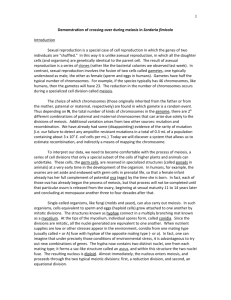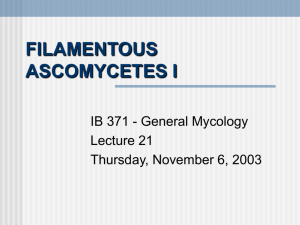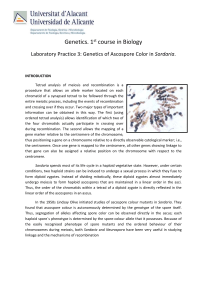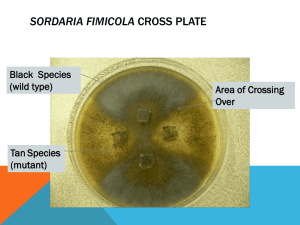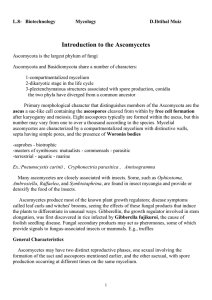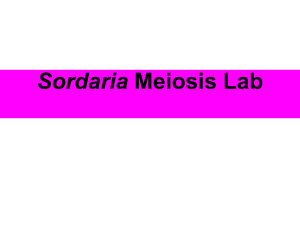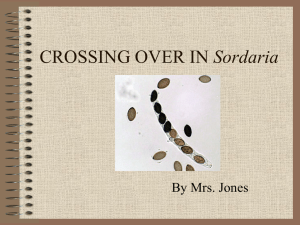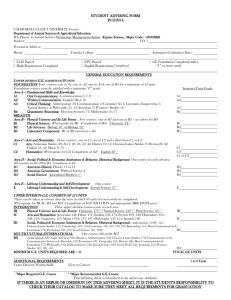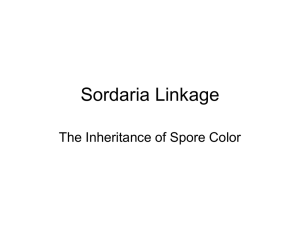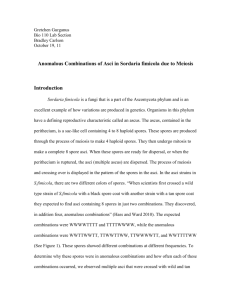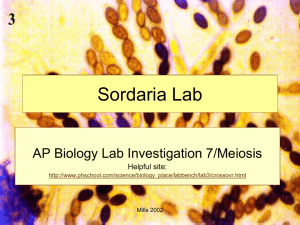Aspergillus
advertisement
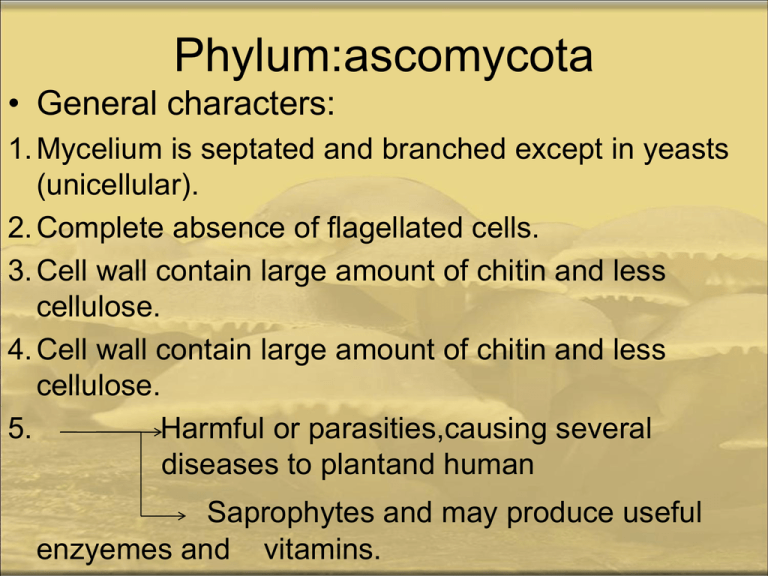
Phylum:ascomycota • General characters: 1. Mycelium is septated and branched except in yeasts (unicellular). 2. Complete absence of flagellated cells. 3. Cell wall contain large amount of chitin and less cellulose. 4. Cell wall contain large amount of chitin and less cellulose. 5. Harmful or parasities,causing several diseases to plantand human Saprophytes and may produce useful enzyemes and vitamins. 6. Asexual reproduction bu non motile conidia,which are produced on a specialized hypae called conidiophore. 7. Sexual reproduction produse ascospores in ascus(sac like structure) usually 8 spores. • Ascocarp: More than one ascus or even one may enclosed in a fruiting body called ascocarp which may be : Cleistothecium perithecium apothecium Cleistothecium: It is globose ,which has no natural openinig the cleistothecium wall may not covered with out growths (appendages). The asci may be arranged in hymenial layer or scatter Asci are liberated by disintegration of the cleistothecial wall. • perithecium: It is a flask shaped ascocar with an apical opening(ostiole). The asci and paraphysis are arranged in a hyminial layer, ascospores libareted from the ostiole. • apothecium: It is a cup or saucer shaped ascocarp the asci and paraphsis ara arranged on the upper surface in a hymenial layer Ascus formation Class: ascomycetes sub class: Protoascomysetes *the asci are nacked not enclosed in ascocarp. Order: endomycetales Family:Saccharomy cetaceae ex:Candida albicans Plectomycetes *asci are enclosed in a cleistothecium Subclass: Euascomysetes *asci or ascus enclosed in an ascocarp. Order:taphrinales family:Taphrinacea e ex: Taphrina deformans Discomycetes *asci are enclosed in apothecium Pyrenomycetes *asci enclosed in aperithecium Subclass:protoascomycetes. Order: Endomycetales. Family: Saccharomycetaceae. Saccharomyces cervisae. • Vegetative structure and economic importance: yeasts are unicellular organisms, oval or spherical shaped, live in colonies with white or yellow, and they are dimorphic. Dimorphism: Is the ability of an organism to grow either unicellular or filamentous according to surrounding condition. Ex: Yeast at 370 c grow as unicellular. at 240 c grow as mycelia • Saccharomyces has avery important role in industries such as fermentation beaking production of vitamins and alchols. Reproduction: 1. budding: • • • • At favorable conditions (food is abundant) the nucleus of the yeast cell divides mitotically and a bud is formed from the wall of mother cell. Then one nucleus passes into this bud with a part of the cytoplasm then this bud separated from the mother cell to give daughter cell. Some times the bud itself may give another bud and the bud do not detached from the mother cells resulting in the fromation of Achain of bud called pseudomycelium. • fission: Parent cell elongates and its nucleus divides to produce two daughter nuclei , then a wall is formed in the middle of the cell from two new cell. sexual reproduction • It takes place when food is exhausted ,it occurs by conjugation between two vegetative cells the process is called hologamy ,this result in the formation of diploid zygot cell which function directly as an ascus and produce ascospores. • 1-Haplopiontic life cycle. 2-diplobiontic life cycle. 3- haplodiplobiontic life cycle. • Candid albicans is ahuman pathogen live in mouth, vagina and cause in young candidomycosis which may treared by amphotrosin c. • Subclass: Euascomycetes • Series: Plectomycetes Order: Asergillales (Asci are scattered) Family: Aspergillaceae Ex: Aspergillus Penicillium Order: Erysiphales family: Erysiphaceae (asci are arranged) Aspergillus • • • • • • *Aspergillus is a widely distrisbuted genus, most are saprophytes on dead organic materials(fruits,jams ,leather, wood,……..) on orange, aspergillus form blue mould. On otherhand some species are parasites. *A.flavus,A.fumigtus and A.niger cause diseases to human and animals known asperilloses also they may cause disease for human ear called otomycosis. A.flavus produce mycotoxins. A. fumigatus give fumes which may contaminate the enviroment and cause respiratory tract infections of human. A.niger is very important for industry it produce about (1819)enzymes including: cellulases xylanases amaylases pectinases inulinases phylase. vegetative structure: • The vegetative structure of Aspergillus is branched and septated mycelia which may: Substarte mycelium: Responsible for fixation and nutrient up take. Aerial mycelium: Appeare above and carrying reproductive organs. Asexual reproduction: • It takes place by means of conidia ,which are formed in chains externally on conidiophores. 1. When asexual reproduction takes place a certain cell of the hyphae become larger and thick walled(foot cell). 2. From each foot cell a vertical, non-septated conidiophore arise each conidiophore ends with a vesicle. 3. A large number of nuclei and cytoplasm migrate into the vesicle. 4. From each vesicle a tubular outgrowths are produced(sterigmata). (sterigmata may be used in identification of Aspergillus). 5. From the tips of sterigmata a chain of conidia are formed. Penicillium • Pencicillium is a saprophytic fungus known as(blue or green mould),it live on several organic substrates(fruits, vegetables,bread,……………….). • Vegetative mycelium is branched and septated. • Some species such as P. chrysogenum produce the antibiotic pencillin(break bonds between peptidoglycan in the cell wall of G+ve bacteria). • Conidiophores are spetated and branched. Order: Erysiphales Family: Erysiphaceae • members of this family are : • Obligate parasites,cause powdery mildew disease. • Produce their asci arranged on hymenial layer inside a cleistothecium. • Depending on: The aggregation of conidia on conidiophores. Number of asci inside the cleistothecium. Type of appendages. *the order Erysiphales is classified as follow Family:Erysiphales Subfamily:phyllactinae *conidia Are solitary Phyllactinea Conidia more one ascus appendages Ascus ,appendages with Bulbous base and pointed tips sub family:Erysipheae leivellula contain more than one are normal myceloid • sub family:Erysipheae Erysiphe uncinulla More than One ascus. Normal appendges More than one ascus curved appendeges Sphaerotheca have one ascus normal appendages Subclass:Euascomycetes Series:pyrenomycetes Family:clavisiptaceae. • This group of fungi profuce their ascus in a perithecium. • Members of this fungi are parasites on graminae and cause ergot disease. • The infected grains contain atoxic substance called ergotamine • This substance has avascoconstrictor effect on the blood vessels and may cause hair falling. Subclass:Euascomycetes Series:Discomycetes • This fungi produce asci in an open ascocarp(apothecium). • The apothecium is cup shaped so these fungi may known as cup fungi. • The asci are arranged on a hymenial layer. order:Pezizales Family:Pezizaceae Peziza sclerotinia Cup fungi cause rot of onion Saprophytes on animal dungs. And decaying wood Form large apothecium. morchella sponge mushroom saprophytes grow on cluster in soil rich in Organic substances Subclass:Euascomyctes Series:Loculoascomycetes • This group of fungi are form their asci in ascostroma . • The ascus has two walls so it called bitunicate ascus • The inner called endotunica extensible and thin • The outer called exotunica inextensible and thick

